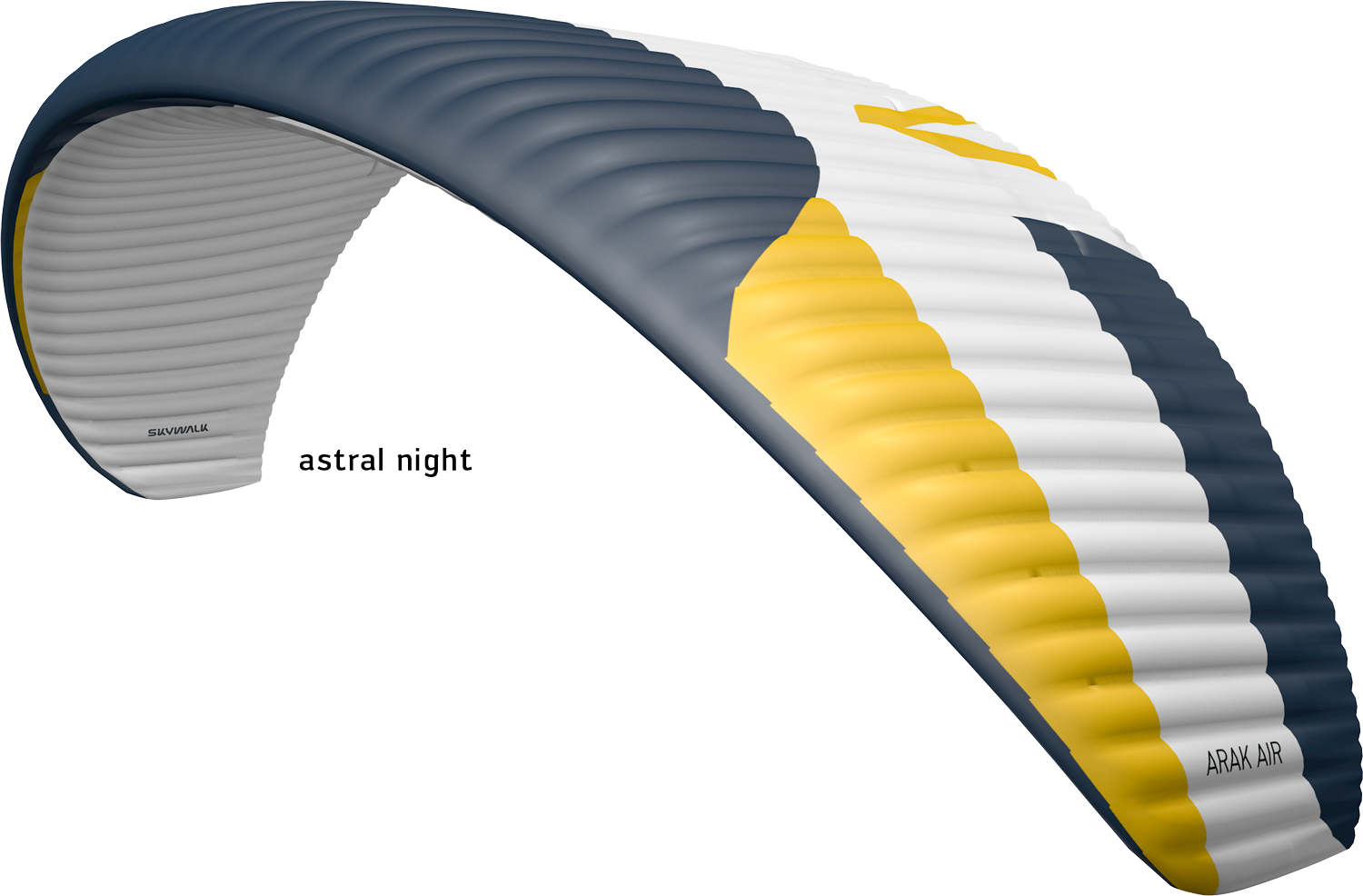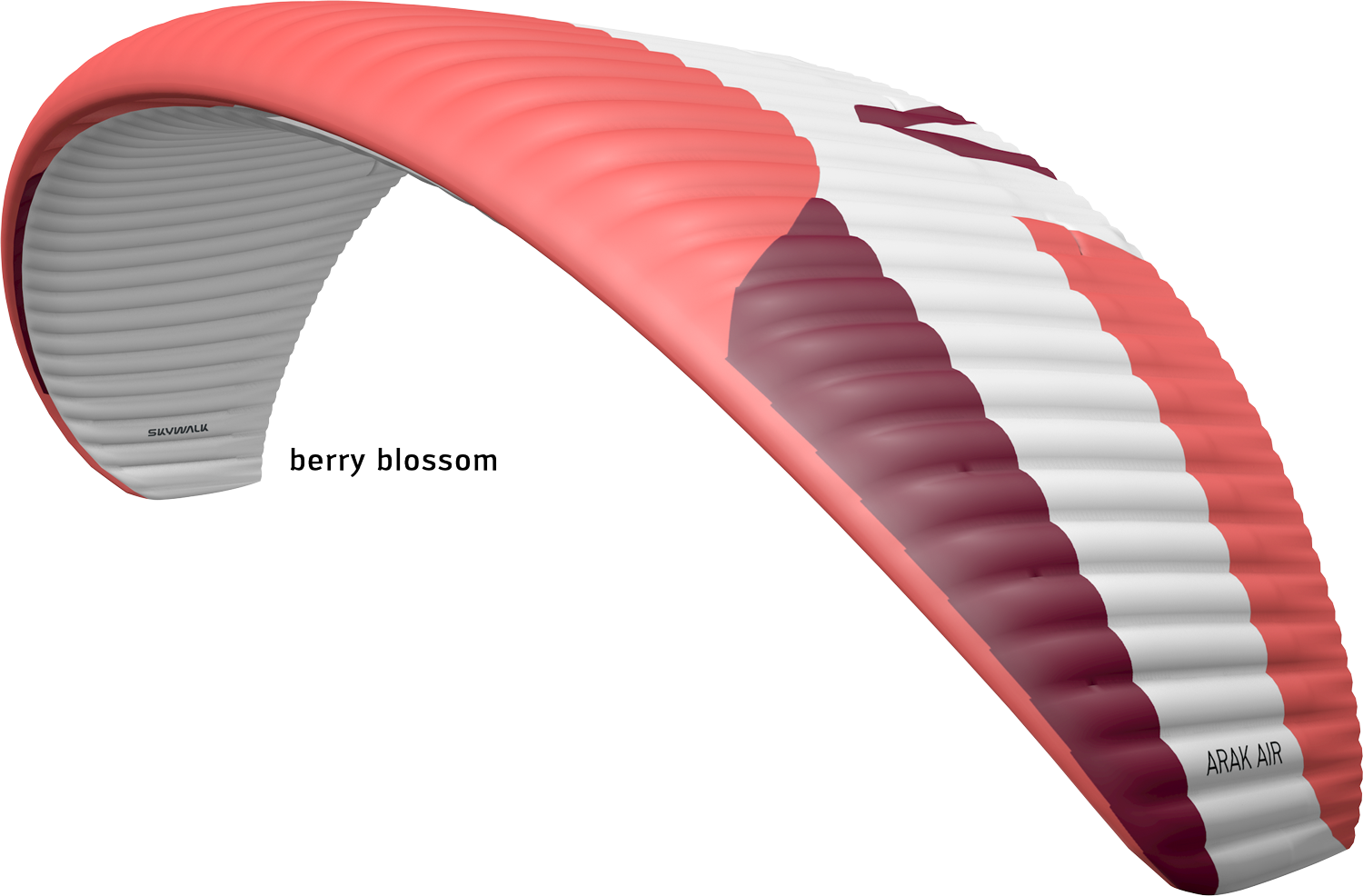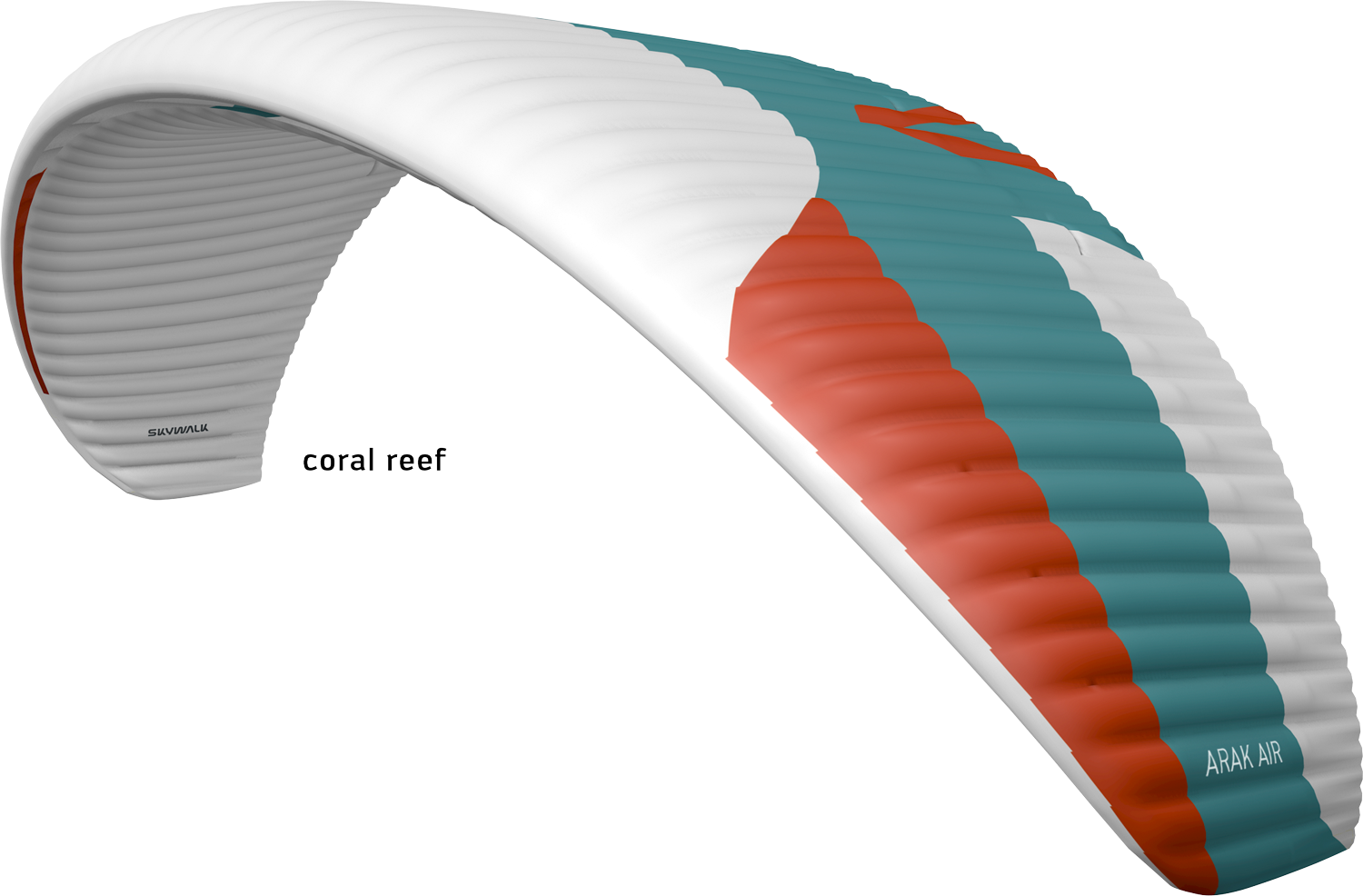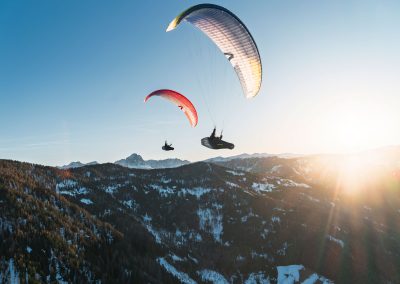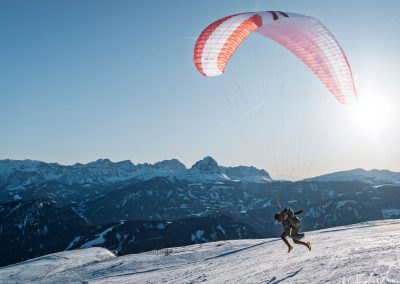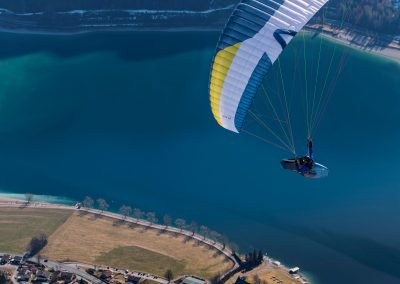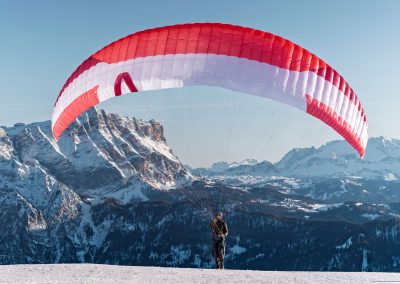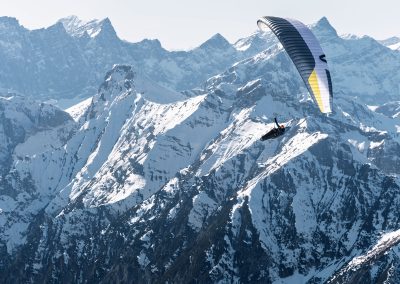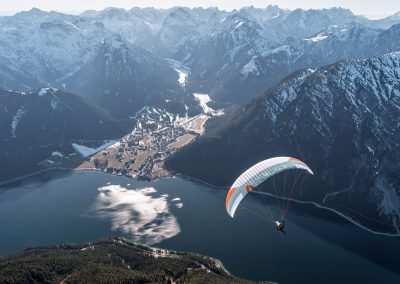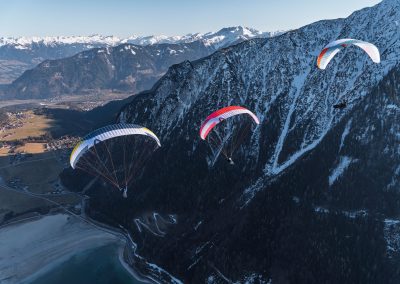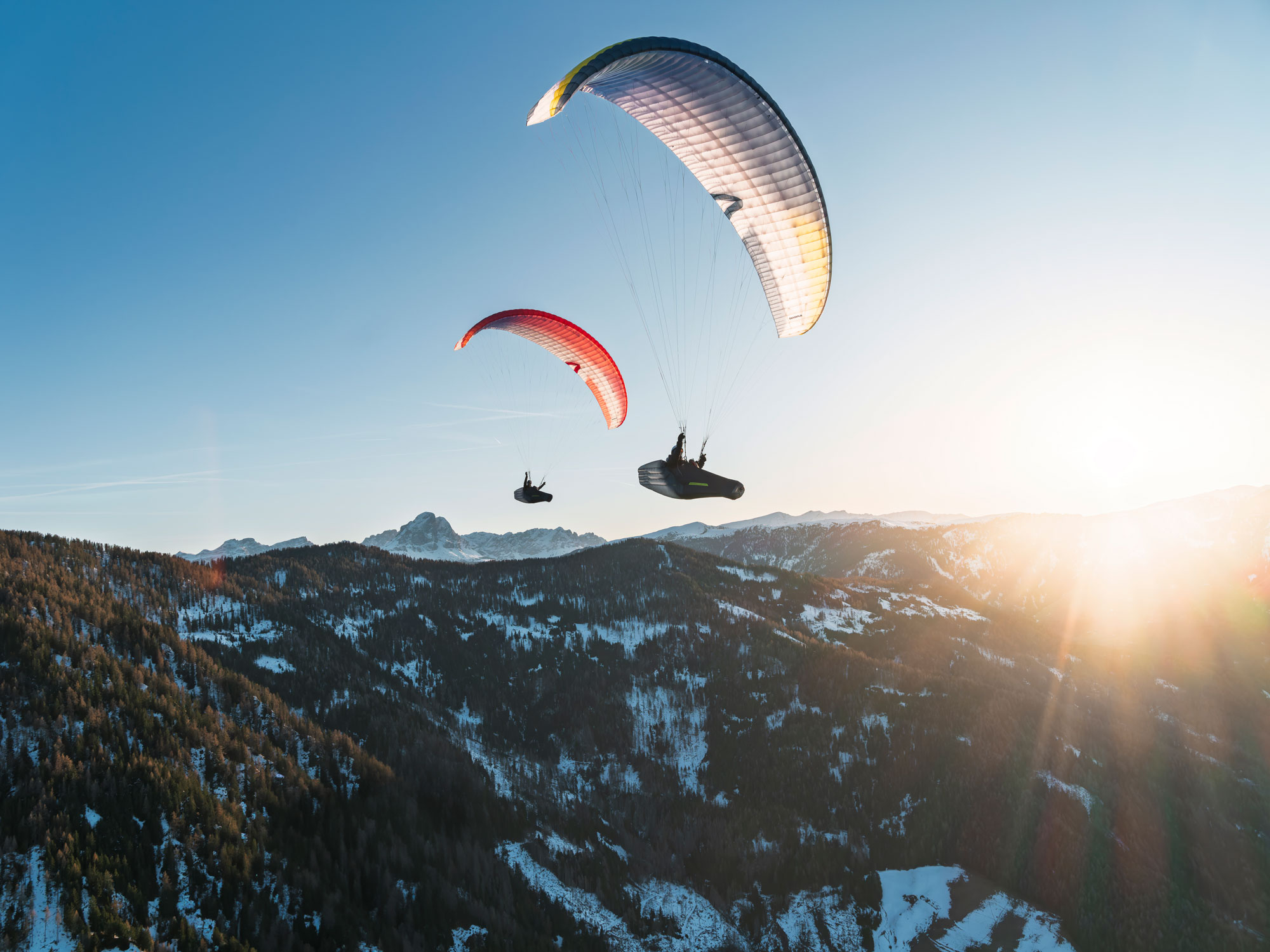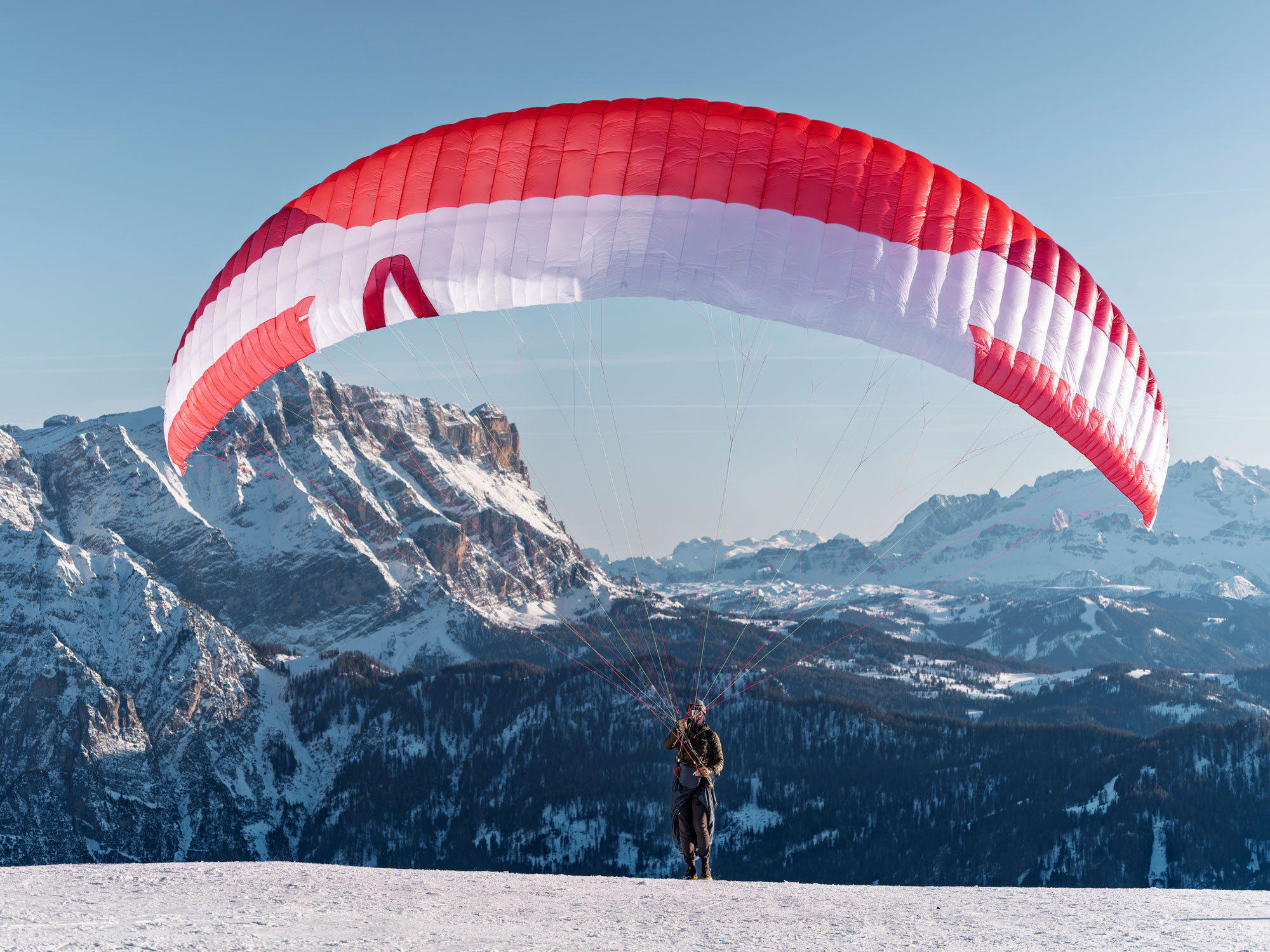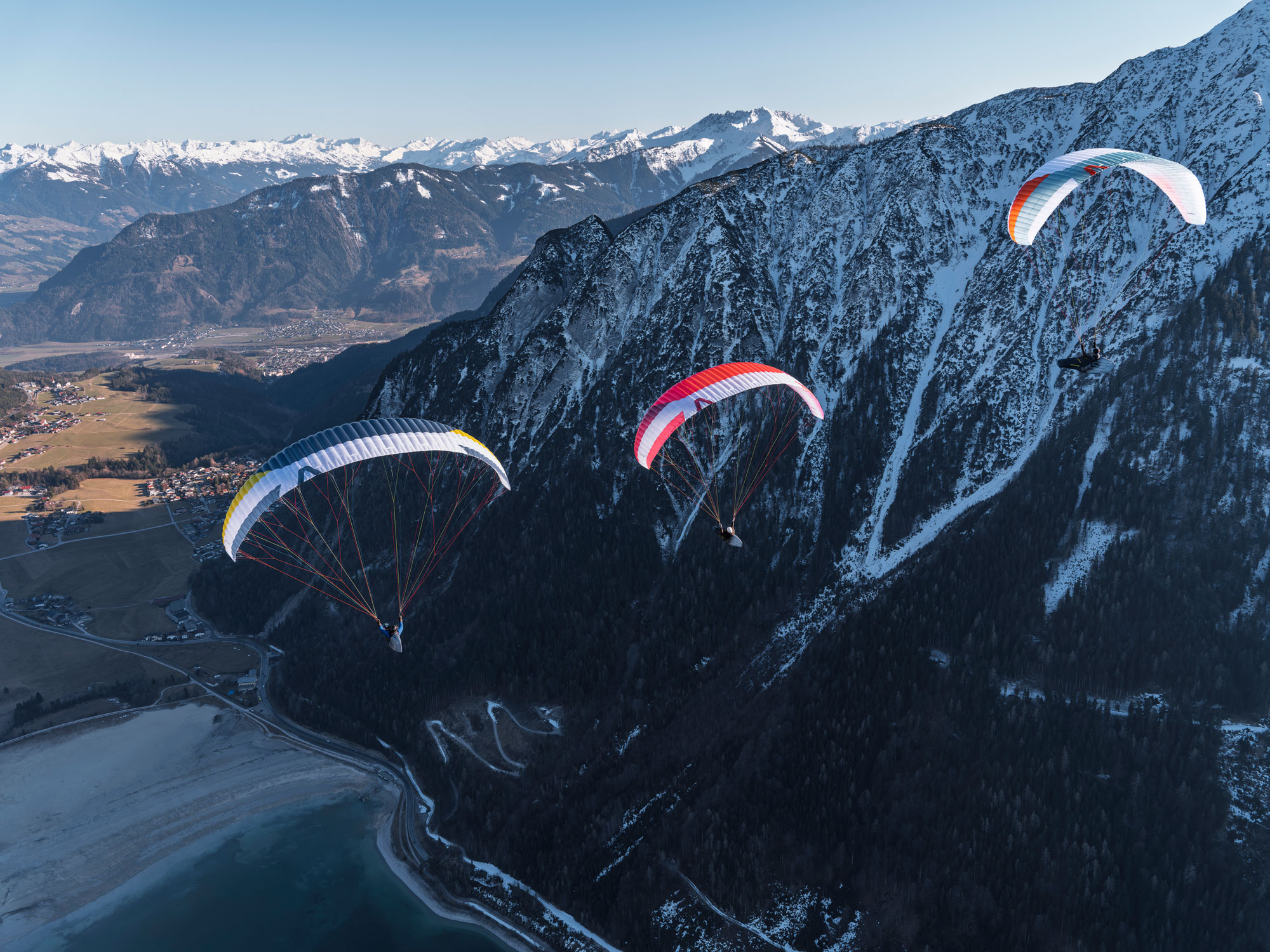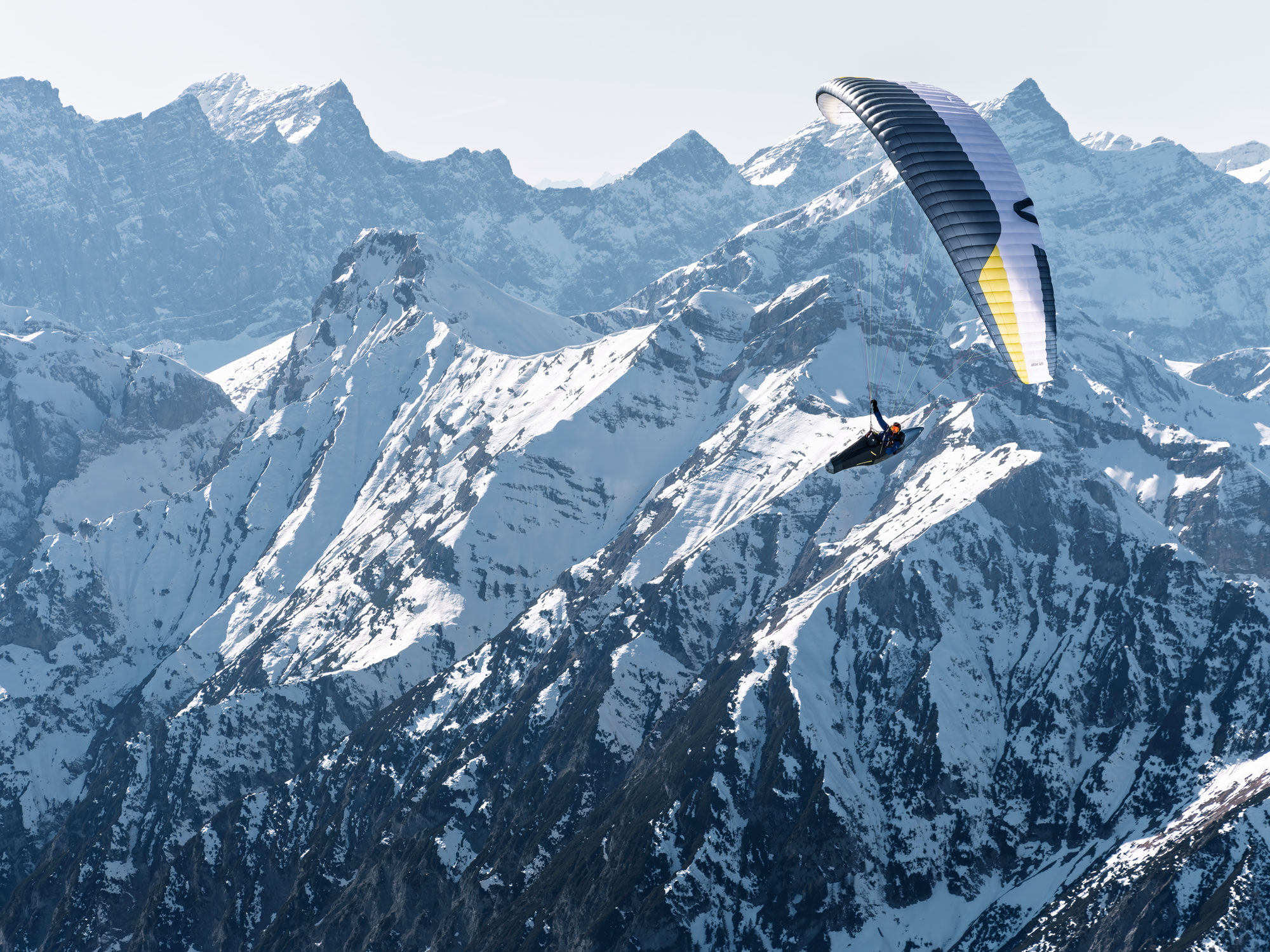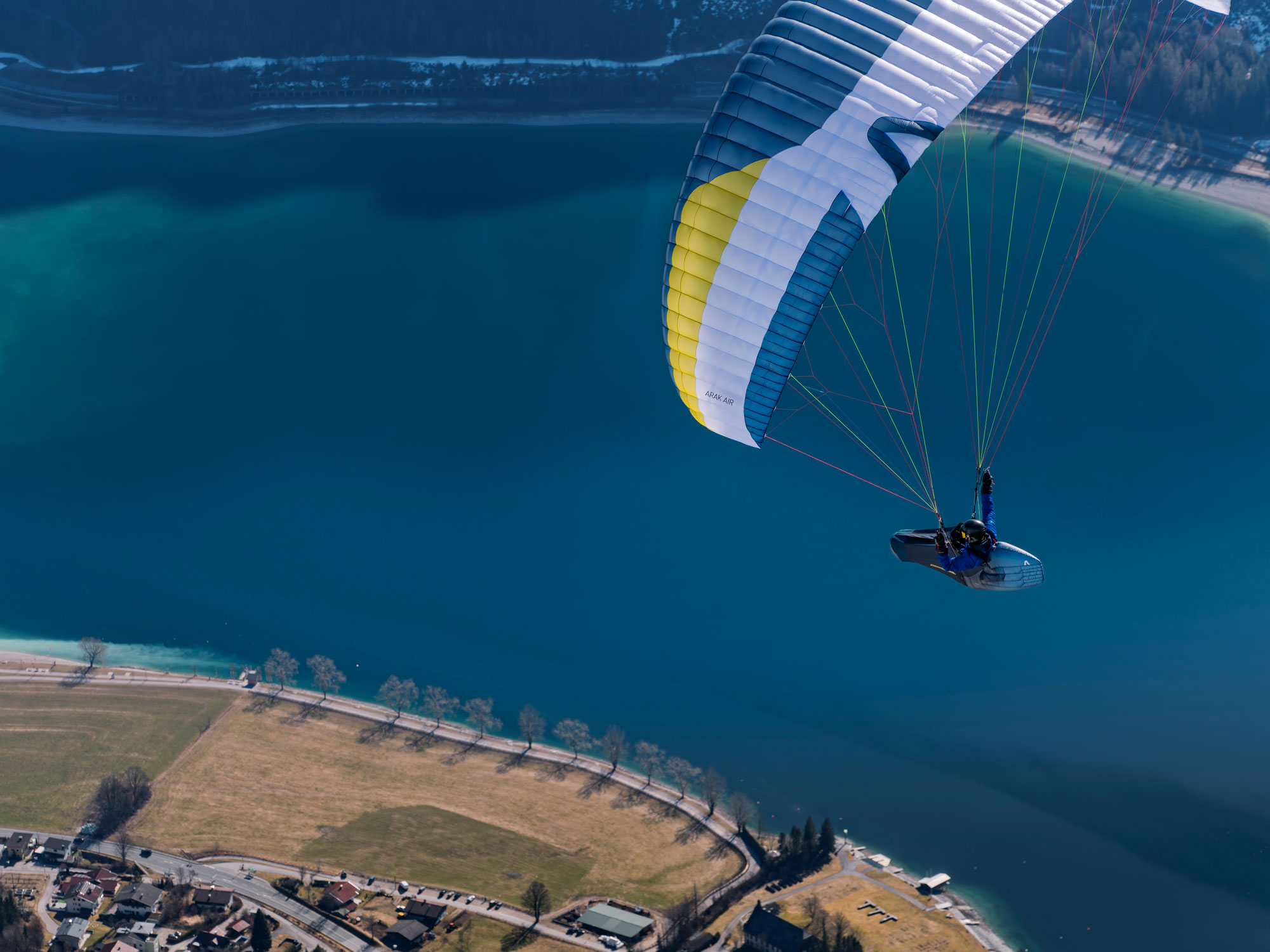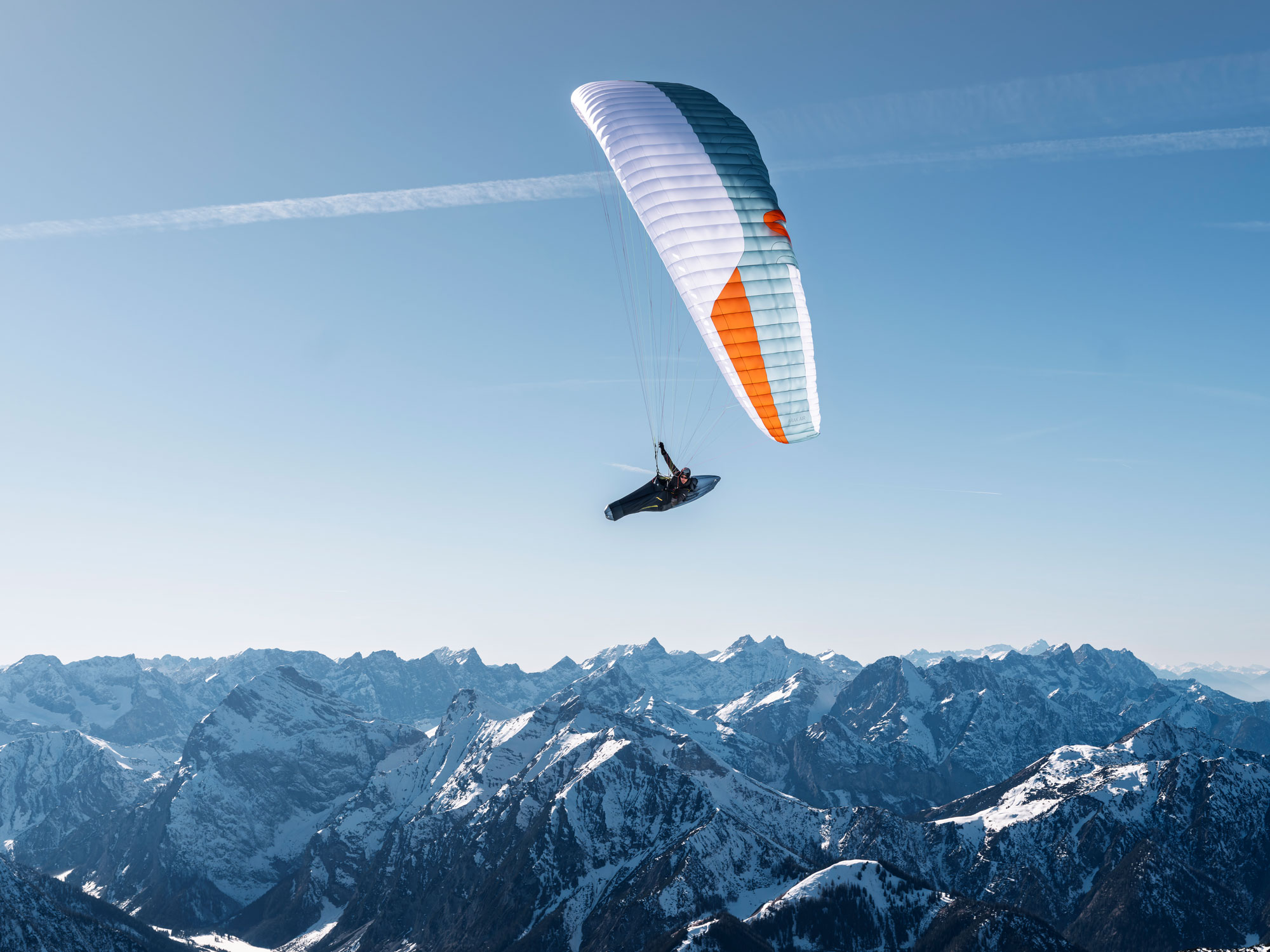Lightness meets versatility
Your adventure begins wherever you want. The ARAK AIR2 combines the versatility of an intermediate wing with the high-tech construction of our X-ALPS gliders. The result: a powerful, easy to fly wing with an outstanding balance of comfort, performance, and handling – the perfect wing for any kind of adventure.
Thanks to its ultralight design, the ARAK AIR2 weighs just 2.9 kg and impresses with its very compact packing size. Going on tour with minimal equipment, taking on new challenges in X-Alps style, or simply enjoying carefree hours in the air – the ARAK AIR2 does it all.
Maximum lightness, maximum versatility, maximum freedom.
Your adventure begins wherever you want. Maximum freedom with minimal weight.
Flight chracteristics
The narrow, dimensionally stable risers and the user-friendly line setup ensure effortless ground handling. Additionally, internally sewn seams on the mini ribs enhance the glider’s durability and longevity – a clear advantage for ground handling and launch preparations. During inflation, the canopy rises steadily and evenly above the pilot, ensuring a precise, safe, and relaxed take-off.
The direct handling allows for precisely controlled bank angles, making dynamic flight maneuvers like wingovers a true pleasure. Wing loading plays a crucial role in flight behavior. The ARAK AIR2 has been designed in such a way that it is also ideal for progressing pilots in the medium to lower weight range and provides a safe, balanced flying experience. Pilots who prefer a more dynamic performance can also fly the wing above the recommended weight range for an even more agile handling experience. In weak thermal conditions, the glider requires a bit more finesse but rewards the pilot with maximum flying fun.
The initially light brake pressure increases linearly and becomes noticeably firmer before the stall point. Thanks to its progressive handling, the wing remains fully controllable at all times and conveys a high level of safety. Its intuitive flight behavior allows for precise control even in demanding conditions, ensuring a safe yet exciting flying fun.
Thanks to its smoothness and intuitive handling, the ARAK AIR2 performance can be easily accessed. With the SPEED CONTROL, the wing can now also be controlled directly via the risers in accelerated flight, ensuring efficient and safe speed control.
More performance, easier handling. Compared to its predecessor, the ARAK AIR2 features an optimized design and advanced manufacturing techniques, resulting in a noticeable increase in performance while maintaining an even easier flight characteristic. Enhanced passive safety and forgiving climb behavior allow for effortless and efficient thermalling, even in demanding conditions, delivering a carefree, high-performance, and enjoyable flying experience.

JET FLAPS
Our JET FLAPS extend the green arc as you approach the stall point, which substantially increases safety and also improves climb performance.
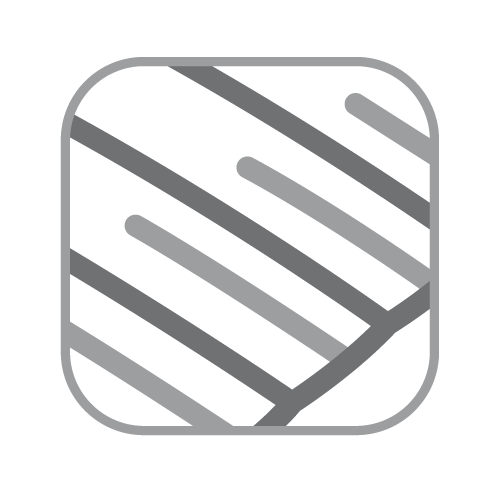
MINI RIBS
Doubling the number of cells at the trailing edge increases its shape stability substantially. Advantage: fewer vortices improve the aerodynamics and with it the performance.

C-WIRES
Nitinol wires sewn into the glider over the anchor points of the C-level lines. Advantages: better load distribution, reduced drag, more performance.

SMART LINK SYSTEM
Color coded seams on the risers to ensure that the risers are connected correctly and without being twisted. red = left; blue = right

SHARK NOSE
Together with a corresponding wing design, the shark nose technology improves pressure distribution in the canopy substantially. Advantages: much more solid flying feeling and substantial performance gain, especially when gliding on bar.

3D-SHAPING
A precise calculation of the leading edge geometry and the installation of an additional strip of fabric reduce wrinkling in this sensitive part of the glider. Advantages: exact wing shape, more performance.

RIGID FOIL
The Rigid Foil Nylon and Nitinol wires on the leading edge help maintain its shape and ensure constant ram air pressure. Advantages: better take-off behavior, more performance and lower canopy weight.

SPEED CONTROL
Riser steering system which allows the pilot to even out turbulence, speed and pitch while flying on speed bar without having to release the speed bar.

SAND RELEASE SYSTEM 2.0
Porous openings of the profile ribs at the trailing edge ensure that sand and dirt in the glider are automatically guided to the wingtip where they can trickle out. This helps preserve the material and relieves the trailing edge.
| Size | 70+ | 80+ | 95+ | 105+ | 115+ |
|---|---|---|---|---|---|
| Cells | 49 | 49 | 49 | 49 | 49 |
| Area flat (m²) | 20.33 | 22.44 | 24.84 | 26.4 | 28.14 |
| Area projected (m²) | 17.41 | 19.22 | 21.28 | 22.61 | 24.1 |
| Wingspan flat (m) | 10.4 | 10.93 | 11.5 | 11.85 | 12.24 |
| Wingspan projected (m) | 8.21 | 8.62 | 9.07 | 9.35 | 9.66 |
| Aspect ratio flat | 5.35 | 5.35 | 5.35 | 5.35 | 5.35 |
| Aspect ratio projected | 3.96 | 3.96 | 3.96 | 3.96 | 3.96 |
| min. profile depth (cm) | 75 | 79 | 81 | 84 | 86 |
| max. profile depth (cm) | 241 | 253 | 267 | 275 | 284 |
| Glider weight (kg) | 2.9 | 3.05 | 3.3 | 3.45 | 3.6 |
| Recommended weight range (kg) | 55 - 70 | 60 - 80 | 75 - 95 | 85 - 105 | 95 - 115 |
| Certified weight range (kg) | 55 - 75 | 60 - 85 | 75 - 100 | 85 - 110 | 95 - 120 |
| Homologation | LTF/EN B | LTF/EN B | LTF/EN B | LTF/EN B | LTF/EN B |
| Upper sail front | Dominico TX-Light |
| Upper sail | Dominico 10D |
| Bottom sail | Dominico 10D |
| Profiles | Porcher Skytex 27g hard |
| Diagonals | Porcher Skytex 27g hard |
| Straps | Porcher Skytex 27g hard |
| Main lines | Liros PPSLS 180, PPSL 120 |
| Middle lines | Liros PPSLS 65, PPSL 120, DC 60 |
| Top lines | Liros DC 60 |
| Main brake lines | Liros DFLP 200/32, PPSL 120 |
| Brake lines | Liros PPSLS 65 |
| Riser | Cousin Freres 7mm webbing |
What is the Smart Link system and how does it work?
The Smart Link system is a feature where each riser has a colored, continuous seam running from the suspension loop up to the C-riser. The red seam indicates the left side, and the blue seam indicates the right side. This ensures that the risers are attached on the correct side. Additionally, it allows for immediate identification if a riser is twisted. These same color-coded seams are also present on the new skywalk harnesses, thereby further enhancing safety.
What advantage does the SPEED CONTROL system offer?
SPEED CONTROL allows you to compensate for turbulence in accelerated flight, change the angle of attack, adjust the speed and make directional corrections without having to step out of the speed bar. This enables a very efficient and fast flying style. The SPEED CONTROL steers the C- and B-risers simultaneously to avoid performance decreasing deformation of the glider, which would happen if you only pulled on the C-risers.
What should I pay attention to when using the SPEED CONTROL?
- Only pull so far that the shackles on the rear riser don’t drop below the line shackles on the A-riser.
- Make sure that the C-riser is not pulled down individually, it is essential that the entire system is actuated.
- At trim speed the SPEED CONTROL may only be used as an emergency control. Under no circumstances should the SPEED CONTROL replace the brake handles!
Is the deterioration on light-cloths higher than on a regular glider cloth?
Light-cloths are thinner than conventional glider-cloths and therefore less resistant against mechanical strain. That means you need to pay more attention on small rocks and bushes. Please avoid any unnecessary contact to the ground. With this strict observance you will have the same durability as with a conventional glider-cloth.
What are the glide ratio (L/D), trim and maximum speeds?
Generally, we do not publish performance data, as releasing such information would be considered unreliable for the following reasons:
1. The difference between aerodynamically favorable and unfavorable harnesses and sitting positions can be as much as a whole L/D number.
2. Performance increases with the size of the glider. A larger glider always performs better than the same glider in a smaller size.
3. In paragliding, there is no standardized procedure for measuring performance data. For example, speed varies with altitude and the associated different air pressure, but also with the total weight of the system.
How do I calculate my take-off weight?
Takeoff weight is calculated by adding the weight of the pilot including clothes to the weight of the equipment. The equipment consists of the harness, the reserve chute, the paraglider itself, and any flight instruments and other baggage you may carry (e.g. rucksack, etc.).
Is it OK for me to shorten the brake lines on my skywalk paraglider?
Changing the length of the brake lines can have a negative effect on the flying characteristics and extreme flight behavior. The paraglider needs a little more lead when flying on speed bar, otherwise the glider could be braked unintentionally, leading to a loss of performance. When performing extreme flying maneuvers, shortening the brake lines too much can cause complications during recovery from collapses, parachutal stall, etc.
Do the nylon wires in the glider need any special attention or packing method?
The stiff plastic rods in the leading edge should be handled carefully when packing to prevent the rigid foils from bending or buckling. However, as these rods are relatively short, no special cell packing bag is required. The remaining reinforcements are made of high-quality Nitinol, which is extremely resistant to kinking and also ensures optimum packing dimensions.
What are JET FLAPS and how do they work?
JET FLAPS are a so-called split flap, like those on large airplanes. When the glider is braked, the airflow is routed through the glider, restoring smooth airflow. This extends brake line travel and softens the stall behavior.
Which advantages do the JET FLAPS on my skywalk glider offer me?
Lower flyable minimum airspeed. The speed range is wider and easier to control. The pilot has more time to react when flying near the stall point.
Your ARAK AIR2 package
- 1x Innerbag for glider
- 1x Compression strap
- 1x Riser bag
- 1x BASIC GUIDE
- 1x Bandana
- 1x Sticker set
- 1x Self-adhesive repair patch


